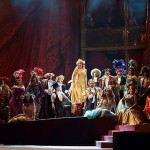Cast
Thaïs: Nino Machaidze
Athanaël: Plácido Domingo
Nicias: Paul Groves
Palemon: Valentin Anikin
Albine: Milena Kitic
Crobyle: Hae Ji Chang
Myrtale: Rebecca Nathanson
Servant: Kihun Yoon
Conductor: Patrick Fournillier
Director: Nicola Raab
Set and Costume Designer: Johan Engels
Lighting Designer: Linus Fellborn
Massenet’s sensuous portrait of a courtesan turned saint and the monk obsessed with her is rarely performed today and hardly an opera that I know well. My only prior experience with it was the Met’s HD transmission starring Renée Fleming and Thomas Hampson. But I was still eager to see it live, especially with the lovely Nino Machaidze and the legendary Plácido Domingo in the leading roles. If I had been more familiar with the piece and seen more traditional productions, maybe I would have enjoyed the performance more fully. In true modern fashion, the staging was more of a commentary on the piece than a straightforward dramatic presentation, and more intellectual exercise than pleasure, at least for me. But it was still worth seeing. The production was visually gorgeous and very thought provoking, and all the performers were excellent, especially the two leads.
Nicola Raab’s staging took its main cue from the fact that Thaïs is a stage actress as well as a courtesan. Almost every scene took place in or around a theatre. The city of Alexandria was depicted as a lavish 19th century cabaret swathed in sumptuous red curtains, where the decadence of 4th century Egypt was replaced by the decadence of 1890s Paris, Massenet’s own time and place. Gaudy pseudo-Alexandrian costumes were present, but they were worn over or alongside 1890s dress and seemed like cosplay, a la the “Spanish” dancers at Flora’s party in La Traviata, or the “Indian” play-within-a-play in Moulin Rouge! (Apparently every opera that features a doomed courtesan has to be staged to resemble Moulin Rouge! nowadays.) The austere convent of Act III was depicted as a theatre too: a gray, crumbling, ancient-looking outdoor theatre, in which the nuns performed their austere rituals on the stage in front of an audience of monks. The message, I thought, was that society forces all women to be “performers” and play roles to please men, either as whores or as madonnas. It never occurs to anyone to let Thaïs just be human, least of all Athanaël but not even Thaïs herself, and therein lies the tragedy. I also detected feminist commentary in the difference between the monks’ garb and the nuns’. While the nuns wore rough robes and veils befitting an ancient desert convent, the monks wore luxuriant velvet-trimmed robes over stylish 19th century suits and top hats, and didn’t look much different from the urbane men at the cabaret. I think a statement about male privilege and monastery vs. convent inequality was being made. Yet surprisingly, that cynicism wasn’t applied to Athanaël. In his dust-colored rags, he looked like an actual 4th century holy man. He seemed to be the only monk genuinely passionate about his faith and vows, not just a gentleman playing a “holiness” game, which made it all the more ironic that he was the one to give in to lust in the end.
I might have liked a production that was slightly more straightforward and less symbolic. Thaïs’s death, in particular, would have been more moving if she had actually seemed to be dying, and if Athanaël could have held her in his arms: as it was, she spent the scene dancing on the convent stage while Athanaël reached pitifully for her from below, and she didn’t visibly die at the end, but stayed standing, reaching toward heaven, while Athanaël fell sobbing to the ground. And the acoustics of the cabaret set weren’t very good. Throughout Act I, Scene II I had trouble hearing the singers. But I definitely appreciated the intelligence and social conscience that went into the staging, not to mention the beautiful costumes and scenery. Thaïs’s bedroom/dressing room in Act II was especially stunning. And without question, apart from the Act I acoustics issue, it provided a strong backdrop for the singers’ performances.
Nino Machaidze’s Thaïs was close to perfection. For starters, of course, she’s a beautiful woman, and she looked every inch the seductress who has a whole city in thrall. But just as seductive as her looks was her darkly shaded, sensuous lyric coloratura voice. A few of her high notes wobbled a little bit, but that was only a small price to pay. Last but not least, her acting skills brought every facet of the role to life: the sultry coquette of her introduction, the vulnerable woman underneath that façade, and the humble “bride of Christ” of the final scenes. She was well matched in every way by Plácido Domingo’s Athanaël. While his legendary voice might have lacked the weight of a true baritone (though I’ve only heard one true baritone sing the role, Thomas Hampson, and that was a few years ago), the warm, burnished, ringing sound that made him a star was still fully in evidence, and he effortlessly captured the character’s blend of tender compassion, fire-and-brimstone sternness, and tortured desires that eventually consume him. Though I must admit, at age 73, he didn’t quite look like the young, handsome, newly ordained monk that the libretto indicates.
The supporting cast was uniformly good, though no one ever stole a scene away from the two stars. The ever-reliable Paul Groves sang handsomely and cut a convincing friendly-playboy figure as Thaïs’s client Nicias, while Valentin Anikin infused the role of the priest Palemon with luxurious dark tones and LA Opera mainstay Milena Kitic brought her customary beautiful mezzo to the role of the abbess Albine. Hae Ji Chang and Rebecca Nathanson sang the roles of the giggly slave girls Crobyle and Myrtale with appropriate flirtatious charm, and the chorus filled their role flawlessly. French conductor Patrick Fournillier brought Massenet’s score to life in all its sparkling, erotic and religiously tender charms, with a true Frenchman’s flair for the style and meaning of the music – during every choral ensemble, he very visibly mouthed the words along with the singers.
While I can’t say I was ever 100% captivated this performance, I’m still very happy I saw it. The production was more “head” than “heart,” but still compelling, and it was all made worthwhile by the outstanding performances of Machaidze and Domingo and the innate seductiveness of Massenet’s music. To anyone who wants to see the last few performances of this production’s run (June 1, 4 and 7), I recommend them wholeheartedly.












LAO
June 2nd, 2014 at 03:37
The role of Myrtale is performed by Rebecca Nathanson, soprano May 25 – June 7. Thanks!
Pamina
June 8th, 2014 at 05:45
Thanks for letting me know. I’ve fixed the review to give credit where it’s due. Next time I won’t skim the program so quickly!